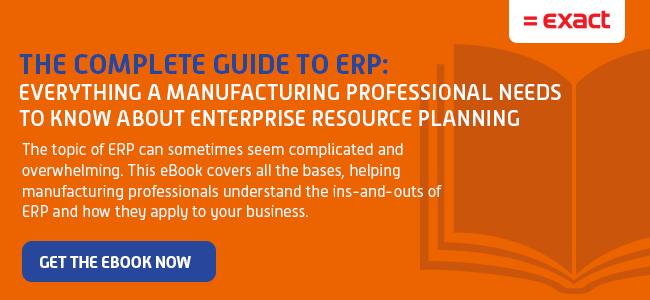ERP systems are an integral part of business operations for manufacturers, especially as small companies scale up production. An ERP system touches every part of your business: helping you track and plan from the moment you receive an order to the moment product ships, through every design change, and, in the off-chance of a recall.
ERP carries with it great potential for improving your business. It also has the potential to be disruptive and overwhelming if implementation is not managed properly.
When you implement your ERP system, you can set yourself up for success by focusing on getting the system to work way your business works, and building in ways to integrate your workforce into the change. To ensure that your ERP system goes in without a hitch, start with these seven steps.
1. Data cleansing
It's not the most glamourous part of an ERP implementation, but it is the necessary start. If this isn't part of your normal routine, start working on data cleansing as soon as you decide to start the search for a new ERP system.
Eliminating bad data helps prevent errors and anomalies bad data can cause during implementation.
2. Document existing and proposed processes
If you are in a regulated industry, you'll have already done this. If you aren't, starting the process now will pay off during your ERP implementation. Either way, make sure your processes are optimal by taking the following steps:
- Eliminate any non-value added steps that currently exist within documented processes and work to simplify processes when creating new documentation.
- Take this opportunity to evaluate the processes you have in place. Vet new solutions by asking people to prove why a new process won’t work as part of any change request.
During implementation, your ERP system will be set up to support the processes you already have in place. ERP will amplify the work you already invested in sound processes.
3. Invest in training
Just because an employee knows how to do their job, doesn't mean they will know how to do their job with ERP. Be sure to include training for system and process changes.
Getting buy-in will set you up for success. And you'll rest easy once the new system is in place, if you also know you've equipped your workforce with the knowledge to get the most out of your new investment.
4. Dedicate the right resources
It's tempting to stack the implementation project on top of regular work, but devoting enough time to the project now is something that will save you later. The payoff from setting things up right comes in time savings when your well-designed processes are executed, and peace of mind knowing your system is capturing all the right data. For key resources, the implementation may be a full-time job.
A smooth ERP implementation is well worth your dedicated time and attention because it helps you set up the most effective business processes.
5. Manage the project to both schedule and budget
Treat the implementation as you would a major development or customer project.
- Whether you use a consultant from your ERP vendor or an in-house project manager, have someone accountable for overall project management.
- Assign resources and budgets to important tasks and hold people accountable for meeting their milestones and staying within budget.
- Create visibility for project tasks and ensure adherence to schedule by setting up workflows for key events.
Nothing ruins the enthusiasm for a new system like continued delays in the “Go Live” date, so managing the implementation project as you would any other project will help you to maintain momentum and enthusiasm.
6. Run a conference room pilot
A conference room pilot is a tool for managing change. You may want to start with one or more small pilot tests and then progress to a full-blown pilot with people from all departments working together.
A full interdepartmental pilot-test builds confidence in the system before you "Go Live" and helps to uncover any previously unidentified process glitches.
7. Prepare for printing and reports
If you print paper invoices, POs or other business documents on forms, make sure you allow plenty of time to design and test them out. Identify current key management reports and their equivalents in the new system. Socialize the new formats so people are familiar with them before they go live.
This is another way to be sure your new system is integrated into your current business operations, and gets full buy-in from the workforce.
Your ERP software is only as good as your ERP implementation.
ERP Implementation is the time you build the connection between your new system and existing business processes. There is a lot on the line, and a great opportunity to improve your business if manged well. Follow the above steps to set yourself up for success!






